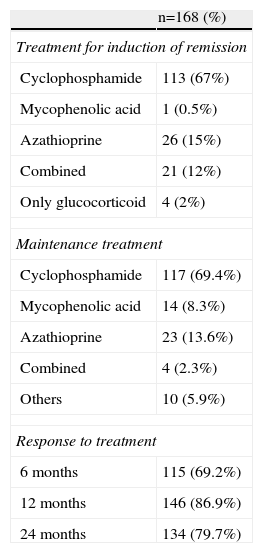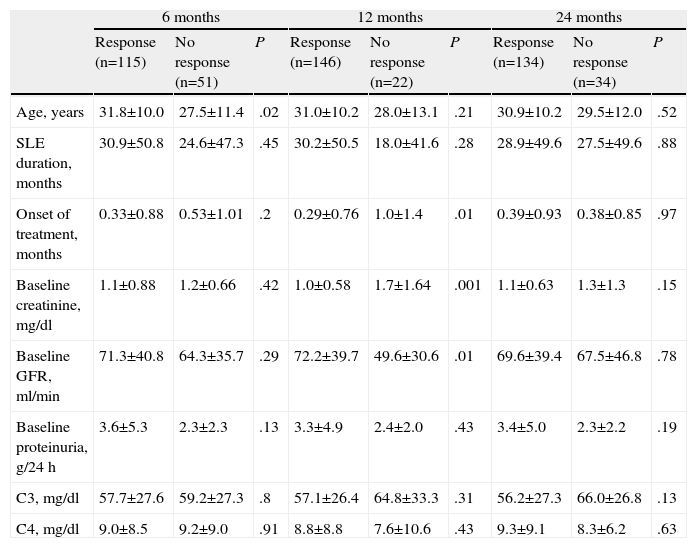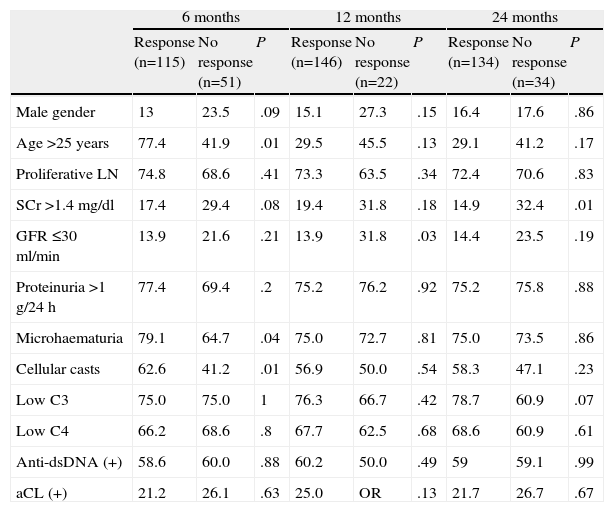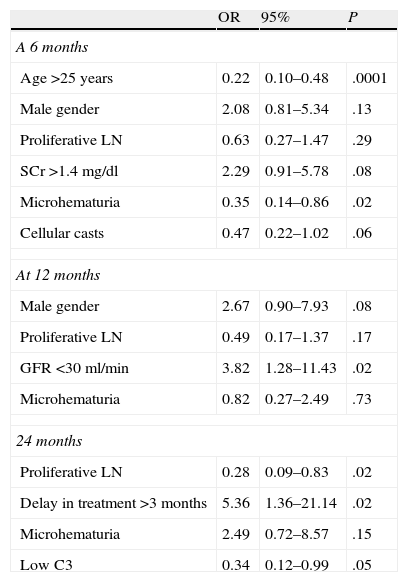To identify prognostic factors associated with response to induction therapy in lupus nephritis (LN) according to the stage of treatment.
Material and methodsWe analyzed a retrospective cohort of patients of systemic lupus erythematosus (SLE) with biopsy-proven LN from January 2001 to December 2008. LN was classified according to WHO. All patients received induction therapy and had a minimum follow-up period of two years. We analyzed 18 clinical and laboratory variables that potentially have predictive value for response to therapy. We identified predictors of therapeutic response at 6, 12 and 24 months by univariate and multivariate analysis; odds ratios (OR) with confidence intervals (CI) 95% were also calculated.
ResultsWe reviewed the clinical records of 168 patients, 141 female (84%). The response rate was 69% at 6 months, 86.9% at 12 months and 79.7% at 24 months. Multivariate analysis found that >25 years of age at diagnosis of LN and the presence of microhematuria were factors associated with good response to induction treatment. At 12 months, baseline creatinine clearance <30ml/min was associated with a poor response to treatment. Finally at 24 months, delay in treatment was a predictor of poor response to treatment and the presence of a histological proliferative NL and low C3 were associated with good response to treatment.
ConclusionsThere are treatment-modifiable factors that can alter aberrant immunologic activity of NF. Therefore, intensive early treatment of lupus nephritis is associated with favorable response to two years.
Identificar los factores asociados con la respuesta al tratamiento en pacientes con nefropatía lúpica.
Material y métodosSe analizó una cohorte retrospectiva de pacientes con lupus eritematoso sistémico (LES) y nefritis lúpica (NL) corroborada por biopsia, clasificada de acuerdo a la Organización Mundial de la Salud (OMS) de junio del 2001 a diciembre del 2008. Todos los pacientes recibieron terapia de inducción a la remisión y fueron seguidos al menos 2 años. Se correlacionaron variables clínicas y de laboratorio con potencial valor predictivo de respuesta terapéutica, a los 6, 12 y 24 meses.
ResultadosSe incluyó a 168 pacientes, 84% mujeres. La tasa de respuesta al tratamiento fue del 69,2% a los 6 meses, el 86,9% a los 12 meses y el 79,7% a los 2 años. En el análisis multivariado se encontró que la edad >25 años en el momento del diagnóstico de la NL y la presencia de microhematuria fueron variables asociadas con buena respuesta al tratamiento de inducción a la remisión. A los 12 meses, una depuración de creatinina basal <30ml/min se asoció a mala respuesta al tratamiento. Finalmente, a los 24 meses, el retraso en el tratamie fue un factor predictor de mala respuesta y la presencia de una forma histológica proliferativa de NL y de C3 bajo se asociaron con buena respuesta al tratamiento.
ConclusionesExisten factores modificables con el tratamiento que pueden alterar la actividad inmunológica aberrante de la NF. Por ello, la intervención terapéutica intensa en los primeros 3 meses de inicio de la nefritis puede llevar a una respuesta favorable a los 2 años.
Systemic lupus erythematosus (SLE) is a chronic disease caused by an aberrant autoimmune response, which by various mechanisms leads to loss of self-tolerance causing inflammation and multiorgan dysfunction; women of childbearing age are the most commonly affected group.1,2 The kidney is commonly involved in disease and 60%–80% of patients develop urinary or renal function abnormalities at some point in the progression of the disease.3 Pathological changes in the kidneys of patients with SLE affect various structures such as glomeruli, tubules, interstitium and blood vessels.4 The prognosis is related to the type of glomerulonephritis found on biopsy. Renal survival is estimated between 83% and 92% at 5 years and 74%–84% at 10 years.5–8
Approximately 5%–15% of patients develop ESRD at 10 years9 which, along with infections and cardiovascular disease are the leading causes of mortality. Death associated with renal disease has been reported in 5%–10%.10,11
Several factors have been associated with an adverse renal prognosis in patients with SLE, including demographic12–15 clinical, biochemical,16,19,20 genetic, immunological and histopathological aspects16,21 and antiphospholipid syndrome,22 but none alone seems to be determinant.
Among the predictors of poor renal outcomes in the short term (6–24 months), high titers of antibodies to double-stranded DNA (anti-dsDNA), low serum complement, age at presentation (children, adolescents and the elderly) thrombocytopenia and hypoalbuminemia may be found. Histologically, subendothelial deposits are the strongest predictor, since the persistence in the number of subendothelial deposits correlates with impaired renal function. Factors associated with poor long-term results are hypertension, hematuria, duration of the disease and lack of response to treatment.23
Treatment is a real challenge, as appropriate intervention with the use of current therapies may improve prognosis, but is also indirectly overshadowed due to the side effects that can develop. There are patients who, despite appropriate intervention and changes in treatment strategies do not reach the expected response. Therefore the objective of this study was to identify potentially predictive factors of response to short-term treatment.
Material and MethodsThe clinical records of patients older than 18 years of age were analyzed; those diagnosed with SLE according to the criteria of the American College of Rheumatology 1982 and 1997, with lupus nephritis (LN) confirmed by renal biopsy, treated at a referral hospital third level were included. The search strategy of the cases was through the Pathology department records of renal biopsies reported during the period from January 1, 2001 to December 31, 2008. LN was classified according to the World Health Organization (1982) criteria and histological activity and chronicity indices were recorded.
Age, gender, date of SLE diagnosis, date of LN diagnosis; treatment for remission induction and maintenance administered, delayed treatment (>3 months); clinical records, which included study variables, were obtained; biochemical parameters, such as serum creatinine, urinary sediment (leukocytes, erythrocytes, cellular casts), creatinine clearance with 24h urine protein quantification, and immunological variables, such as antinuclear antibodies, anti-dsDNA, C3, C4, anticardiolipin antibodies, IgG and IgM, were recorded. Data were analyzed at the time of the detection of LN and at 6, 12 and 24 months of follow-up.
Definition of Renal ResponseFor analysis, patients were classified as responders and non-responders. A patient was considered as a responder when there was at least a 25% increase of the glomerular filtration rate (GFR) (assuming baseline was abnormally low: <75ml/min) or had normal renal function (GFR >90ml/min) a ratio in urine protein/creatinine ratio <0.2–2, and inactive urinary sediment (≤5RBCs per field, ≤5leukocytes per field and the absence of cellular casts in the urinalysis). A patient was considered a non-responder if there was a change in the GFR or showed a 25% decrease in estimated GFR (Cockcroft), presence of end-stage renal disease, active urinary sediment (>5 erythrocytes >5 WBC and/or ≥1 cell cylinder per field).24
Statistical AnalysisQuantitative variables were expressed as standard deviations and qualitative variables as percentages. We conducted a bivariate analysis of potential predictors of response factors measured with the chi-square or Student t-test when so required. Subsequently, a multivariate analysis was performed using a model of proportional risk regression to evaluate potential predictors of response to treatment such as clinical, biochemical, serological, histological and therapeutic variables. Odds ratios (OR) were calculated with a confidence interval of 95% for the variables related to therapeutic response using SPSS software V 0.17. A P<.05 was considered statistically significant. However, multivariate analysis for those variables with a P value <.1 or considered clinically relevant was included.
ResultsFor this study, data from 168 patients with complete clinical records were included. Overall, 141 were female (84%), with a mean age at diagnosis of LN of 30.4±10.6 years and a time since onset of SLE of 28.0±48 8 months. LN was the initial manifestation of the disease in 94 (56.5%) patients. Renal biopsy showed class II LN in 33 patients (19.6%), class III in 28 patients (16.6%), class IV in 92 patients (54.7%), class V in 7 patients (4.1%) and combined histological types in 7 patients (4.1%). The treatment response rate was 69.2% at 6 months, 86.9% at 12 months and 79.7% at 2 years (Table 1).
Treatments Used.
| n=168 (%) | |
| Treatment for induction of remission | |
| Cyclophosphamide | 113 (67%) |
| Mycophenolic acid | 1 (0.5%) |
| Azathioprine | 26 (15%) |
| Combined | 21 (12%) |
| Only glucocorticoid | 4 (2%) |
| Maintenance treatment | |
| Cyclophosphamide | 117 (69.4%) |
| Mycophenolic acid | 14 (8.3%) |
| Azathioprine | 23 (13.6%) |
| Combined | 4 (2.3%) |
| Others | 10 (5.9%) |
| Response to treatment | |
| 6 months | 115 (69.2%) |
| 12 months | 146 (86.9%) |
| 24 months | 134 (79.7%) |
All patients were treated with high doses of corticosteroids (methylprednisolone pulses 3g total dose were administered in 60% of patients, the remaining patients received prednisone 1mg/kg/day) and 113 (67%) of them received IV cyclophosphamide (0.5–1g/m2 SC/dose) monthly (Table 1). The rest were mainly treated with immunosuppressants such as azathioprine (75–150mg/day) and mycophenolic acid (1–3g/24h). One hundred and fifteen (69.2%) patients were responders. NR patients had a younger age (27.5±11.4 vs 31.8±10.0, P=.02) compared with responders (Table 2). In bivariate analysis found that patients >25years (P<.01), the presence of hematuria (P=.04) and cellular casts (P=.01) were variables associated with an increased likelihood of therapeutic response (Table 3) and no associated factors were found associated to a lack of therapeutic response. In the multivariate analysis, age >25 years at diagnosis of LN (OR 0.22, 95% CI, 0.10–0.48, P=.0001) and the presence of microhematuria (OR 0.35, 95% CI, 0.14–0.86, P=.02) were associated with good response to treatment for remission induction. An increased risk was found in males and patients with elevated serum creatinine for a lack of therapeutic response, but with no statistically significant value.
Baseline Demographic Characteristics According to the Therapeutic Response.
| 6 months | 12 months | 24 months | |||||||
| Response (n=115) | No response (n=51) | P | Response (n=146) | No response (n=22) | P | Response (n=134) | No response (n=34) | P | |
| Age, years | 31.8±10.0 | 27.5±11.4 | .02 | 31.0±10.2 | 28.0±13.1 | .21 | 30.9±10.2 | 29.5±12.0 | .52 |
| SLE duration, months | 30.9±50.8 | 24.6±47.3 | .45 | 30.2±50.5 | 18.0±41.6 | .28 | 28.9±49.6 | 27.5±49.6 | .88 |
| Onset of treatment, months | 0.33±0.88 | 0.53±1.01 | .2 | 0.29±0.76 | 1.0±1.4 | .01 | 0.39±0.93 | 0.38±0.85 | .97 |
| Baseline creatinine, mg/dl | 1.1±0.88 | 1.2±0.66 | .42 | 1.0±0.58 | 1.7±1.64 | .001 | 1.1±0.63 | 1.3±1.3 | .15 |
| Baseline GFR, ml/min | 71.3±40.8 | 64.3±35.7 | .29 | 72.2±39.7 | 49.6±30.6 | .01 | 69.6±39.4 | 67.5±46.8 | .78 |
| Baseline proteinuria, g/24h | 3.6±5.3 | 2.3±2.3 | .13 | 3.3±4.9 | 2.4±2.0 | .43 | 3.4±5.0 | 2.3±2.2 | .19 |
| C3, mg/dl | 57.7±27.6 | 59.2±27.3 | .8 | 57.1±26.4 | 64.8±33.3 | .31 | 56.2±27.3 | 66.0±26.8 | .13 |
| C4, mg/dl | 9.0±8.5 | 9.2±9.0 | .91 | 8.8±8.8 | 7.6±10.6 | .43 | 9.3±9.1 | 8.3±6.2 | .63 |
Bivariate Analysis.
| 6 months | 12 months | 24 months | |||||||
| Response (n=115) | No response (n=51) | P | Response (n=146) | No response (n=22) | P | Response (n=134) | No response (n=34) | P | |
| Male gender | 13 | 23.5 | .09 | 15.1 | 27.3 | .15 | 16.4 | 17.6 | .86 |
| Age >25 years | 77.4 | 41.9 | .01 | 29.5 | 45.5 | .13 | 29.1 | 41.2 | .17 |
| Proliferative LN | 74.8 | 68.6 | .41 | 73.3 | 63.5 | .34 | 72.4 | 70.6 | .83 |
| SCr >1.4mg/dl | 17.4 | 29.4 | .08 | 19.4 | 31.8 | .18 | 14.9 | 32.4 | .01 |
| GFR ≤30ml/min | 13.9 | 21.6 | .21 | 13.9 | 31.8 | .03 | 14.4 | 23.5 | .19 |
| Proteinuria >1g/24h | 77.4 | 69.4 | .2 | 75.2 | 76.2 | .92 | 75.2 | 75.8 | .88 |
| Microhaematuria | 79.1 | 64.7 | .04 | 75.0 | 72.7 | .81 | 75.0 | 73.5 | .86 |
| Cellular casts | 62.6 | 41.2 | .01 | 56.9 | 50.0 | .54 | 58.3 | 47.1 | .23 |
| Low C3 | 75.0 | 75.0 | 1 | 76.3 | 66.7 | .42 | 78.7 | 60.9 | .07 |
| Low C4 | 66.2 | 68.6 | .8 | 67.7 | 62.5 | .68 | 68.6 | 60.9 | .61 |
| Anti-dsDNA (+) | 58.6 | 60.0 | .88 | 60.2 | 50.0 | .49 | 59 | 59.1 | .99 |
| aCL (+) | 21.2 | 26.1 | .63 | 25.0 | OR | .13 | 21.7 | 26.7 | .67 |
aCL, anticardiolipin antibodies; anti-dsDNA, antibodies to double-stranded DNA; SCr, serum creatinine; LN, lupus nephritis; GFR, glomerular filtration rate.
Results are expressed as percentages.
Most patients received maintenance therapy with IV cyclophosphamide (69.4%) every 2–3 months (Table 1). 86.9% of patients had treatment response at one year. Non-responders had higher creatinine levels and a creatinine clearance below baseline compared with responders (Table 2). On bivariate analysis, we found that a baseline creatinine clearance <30ml/min was associated with lack of response (P=.03) (Table 3). In the multivariate analysis, this same laboratory parameter (OR 3.82, 95% CI, 1.28–11.43, P=.02) remained as an independent variable associated with a poor response to treatment (Table 4). As occurred at 6 months, male had an increased risk for treatment failure, but with no statistically significant value.
Predictors of Lack of Therapeutic Response (Multivariate Analysis).
| OR | 95% | P | |
| A 6 months | |||
| Age >25 years | 0.22 | 0.10–0.48 | .0001 |
| Male gender | 2.08 | 0.81–5.34 | .13 |
| Proliferative LN | 0.63 | 0.27–1.47 | .29 |
| SCr >1.4mg/dl | 2.29 | 0.91–5.78 | .08 |
| Microhematuria | 0.35 | 0.14–0.86 | .02 |
| Cellular casts | 0.47 | 0.22–1.02 | .06 |
| At 12 months | |||
| Male gender | 2.67 | 0.90–7.93 | .08 |
| Proliferative LN | 0.49 | 0.17–1.37 | .17 |
| GFR <30ml/min | 3.82 | 1.28–11.43 | .02 |
| Microhematuria | 0.82 | 0.27–2.49 | .73 |
| 24 months | |||
| Proliferative LN | 0.28 | 0.09–0.83 | .02 |
| Delay in treatment >3 months | 5.36 | 1.36–21.14 | .02 |
| Microhematuria | 2.49 | 0.72–8.57 | .15 |
| Low C3 | 0.34 | 0.12–0.99 | .05 |
SCr, serum creatinine; LN, lupus nephritis; GFR, glomerular filtration rate.
At 2 years follow-up, 79% of patients had therapeutic response and we found no differences in baseline demographic variables in both groups (Table 2). Upon bivariate analysis, increased serum creatinine >1.4mg/dl (P=.01) was associated with lack therapeutic response (Table 3). In the multivariate analysis, the delay in treatment (OR 5.36, 95% CI, 1.36–21.14, P=.02) was an independent risk factor associated with poor therapeutic response (Table 4). On the other hand, the presence of a proliferative histological pattern of LN (OR 0.28, 95% CI, 0.09–0.83, P=.02) and the presence of low C3 (OR 0, 34, 95% CI, 0.12–0.99, P=.05) were associated with good response to treatment.
DiscussionOur study analyzed various clinical, biochemical, histological and immunological variables that can influence the therapeutic response, both induction and maintenance, in SLE and LN patients at 6, 12 and 24 months. The results showed that the risk factors associated with an increased likelihood of therapeutic response at different times were greater than 25 years of age, microhematuria, low C# and proliferative LN. On the other hand, the variables associated with poor therapeutic response were creatinine clearance <30ml/min at baseline and delayed start of immunosuppressive therapy for more than 3 months at 12 and 24 months of treatment, respectively.
The presence of renal disease in the clinical course of SLE is considered a factor that adversely affects the morbidity and mortality of the disease. The course of LN is difficult to predict for several reasons, including the heterogeneity of the clinical presentation, different classification criteria, the incidence of histologic transformation and the various treatments used. There is no decisive factor for predicting LN and a number of demographic, clinical, laboratory and histopathological factors have been shown to influence outcomes and response to treatment. The interaction of these factors are likely to determine the final result and one must take into account all factors in making the most appropriate decision for each treatment regimen.25 Renal prognosis is not the same in all ethnic groups. The trend is clearly worse in African Americans and Latin Americans, in which genetic and socioeconomic factors appear to be involved. Latin American patients with a mid-class socioeconomic status had higher Systemic Lupus International Collaborating Clinic index scores and patients who died were of low socioeconomic status.26 Poverty is a risk factor for the progression of proliferative LN.27 It is noteworthy that in a high percentage of our patients, LN was the initial manifestation. Previous studies in Latin American and Caucasian populations reported that in 5.7% and 10% of patients, respectively, LN was the initial manifestation.26,28 This may be explained by the fact that our hospital is a referral center serving a highly selected population.
Various factors affecting renal outcome were described. Among the demographic variables, it has been reported that a juvenile lupus onset12 and13 in young adults, those under 40 years, have a higher number of exacerbations.28
In our study, we found that patients younger than 25 years are less likely to respond to treatment for remission induction. It has been reported that men have poorer prognosis compared with14 women, perhaps because a later diagnosis is made, they have lower remission rates, more frequent relapses, show decreased renal survival and increased mortality.29–31 Unlike other studies, we found that males have a lower probability of response to treatment, something which was not statistically significant due to the effect of sample size (16%).
Furthermore, we have identified various biochemical and clinical predictors present in LN related to poor renal results, including elevated serum creatinine, nephrotic syndrome, hipocomplementemia, decreased hematocrit,16–18 low hemoglobin, thrombocytosis32 persistent hypertension, massive proteinuria and acute renal failure.33 In our study, no blood count was performed or analyzed; the only biochemical parameters studied was creatinine clearance <30ml/min which was a biochemical variable associated with poor response to treatment at 12 months. In contrast to those reported in the literature, we found that microhematuria and low serum C3 were associated with good response to treatment.16–18 This apparent contradiction may be due to intense treatment due to the severity of LN in our patients. Systemic hypertension was analyzed but showed no association with the type of response.
The association of various nephritogenic autoantibodies with renal disease activity and prognosis has been investigated in several international cohorts. The combination of anti-DNA and anti-C1q indicates greater renal activity and predicts poor renal outcomes.34 Antiphospholipid antibodies are positive in up to 27% of patients with nephritis and have been associated with renal relapse and reduced survival,21,22 being an independent risk factor for the development of chronic kidney disease.35 The presence of anti-Ro has been associated with failure to achieve remission.17 Due to the retrospective design of the study, we are not able to measure all of these antibodies.
Histological features that have been associated with a poor renal prognosis are the delay between making the biopsy and the onset of proliferative forms16, membranous nephritis32, high levels of renal activity33 and chronicity,16,36 that when related to the presence of crescents and thrombotic microangiopathy worsen the prognosis,37 which can translate into a late diagnosis, a silent disease presentation, histologic transformation,38 a localization of immune deposits and capillary thrombosis. It has been recently described that the presence of α-smooth muscle actin at the interstitial level is related to a poor response to treatment, and is a useful marker for predicting renal fibrosis.39 Our patients with proliferative histological forms of LN are more likely to respond to treatment, perhaps because they are treated with greater intensity. This group of patients is associated with increased relapse rates and terminal renal failure.40 On the other hand, we did not analyze the activity and chronicity indices due to the low number of biopsies that calculated these scores.
Predictors of response found in our study differed according to the different stages of treatment, reflecting histological changes that are potentially reversible. It has been shown that, in kidney biopsies taken in clinically active LN, histological activity data on chronicity predominates. It has been found that the amount of subendothelial deposits correlates with parameters such as proteinuria and serum creatinine.40 Intense immunosuppressive treatment significantly reduces the number of subendothelial immune deposits, resulting in improvement of laboratory parameters.41 These histological changes in patients with repeated renal biopsies at the end of remission induction therapy differ between responders and nonresponders. As reported, the delay in the start of induction therapy was a predictor of poor therapeutic response, which can translate into a predominance of chronic histological changes conditioned by a late therapeutic intervention.42 Furthermore, in our study, proliferative histological types were associated with a greater likelihood of response to treatment, which may represent potentially modifiable increased inflammatory activity. Of interest, in our study, factors associated with treatment response have different meanings over time. These results indicate that the response to treatment depends on dynamic changes in the pathogenesis of LN, which has been demonstrated in experimental models.43 For example, inflammatory chemokines and cytokines and markers of myeloid cells dominate in acute glomerulonephritis. In chronic glomerulonephritis there is an increase in the expression of genes associated with tissue remodeling and repair. Moreover, in a transitional stage of glomerulonephritis, there is an increase in the expression of genes involved in the final common pathway leading to fibrosis and irreversible glomerular injury, such as transforming growth factor beta 2 and protein bound to insulin-like 2 growth factor, among others. It has been recently found that human serum sIL-7R may be a marker of activity in the kidney, even earlier than anti-dsDNA and serum complement.44
Limitations of our study include its retrospective design. It is necessary to conduct an analysis stratified by treatment regimen, which could not be performed due to the sample size. Furthermore, other nephritogenic antibodies, such as anti-C1q or antinucleosomal antibodies, were not determined. In our hospital, LN is treated by multiple specialties (nephrology, internal medicine and rheumatology), which use different doses of the drugs. Furthermore, our study did not analyze relapse or progression to end stage disease, nor was mortality measured as an outcome as reported in other studies.45,46
In conclusion, predictors of response to treatment in our patients with LN were, at 6 months, age >25 years and microhematuria; at 24 months, proliferative forms of LN and low C3; and at12 months, low creatinine clearance and delayed treatment at 2 years. Timely therapeutic intervention for LN is associated with a favorable response at 2 years.
Long-term studies will identify the impact of these response factors found in early stages of the disease.
Ethical ResponsibilitiesProtection of people and animalsThe authors declare that no experiments have been performed on humans or animals.
Data confidentialityThe authors declare that they have followed the protocols of their workplace regarding the publication of data from patients and that all patients included in the study have received sufficient information and have given their written informed consent to participate in the study.
Right to privacy and informed consentThe authors state that no patient data appears in this article.
FinancingNone.
Conflict of InterestThe authors declare no conflicts of interest.
Please cite this article as: Miranda-Hernández D, Cruz-Reyes C, Angeles U, Jara LJ, Saavedra MA. Predictores de respuesta al tratamiento en pacientes con nefritis lúpica. Reumatol Clin. 2014;10:164–169.










